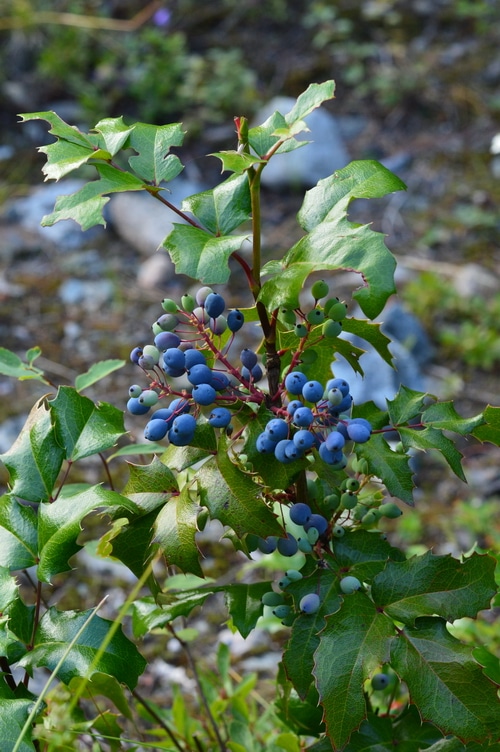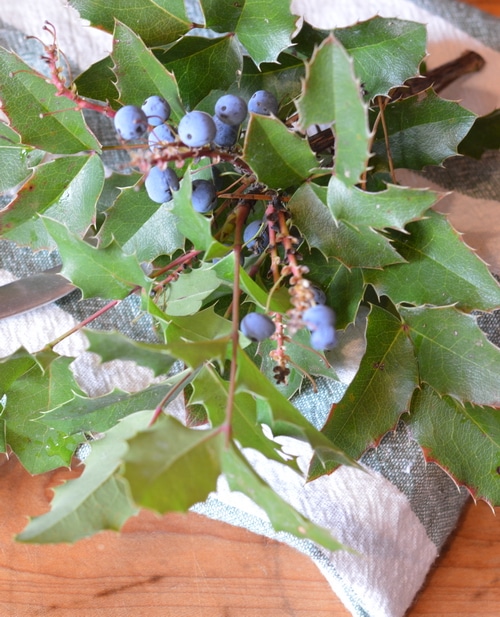Foraging wild Oregon grapes while they’re ripe this autumn. The small blue berries have a lemon-like tartness and make awesome jams and jelly for winter enjoyment.
The Oregon grapes are deep purple and abundant in September in zone 3. This year we’ve had ample rain, and the grapes are plump, astringent, sour but satisfying. The bears have been helping themselves to the grapes on the trail, as evidenced by their seedy scat.
Inside my forest garden, behind a 10 foot, protected fence, the grapes are holding on the mahonia plants, getting plumper in the rain. This is the ideal time to harvest them for Oregon grape jelly. They will remain on the plant until they are harvested or eaten by wild creatures.

Oregon Grapes
Oregon grapes are wild, purple fruit that grow on the Mahonia shrub or Oregon grape plant, a member of the Barberry family. The Oregon grape is a low sprawling shrub with waxy, dark green leaves that look like holly leaves.

The spring flowers of Oregon grape in May
There are three main species of Mahonia in British Columbia. The Oregon grape (Mahonia nervosa, formerly Berberis nervosa) grows to 2 feet tall, with long stems of opposite leaflets, sometimes showing 21 leaflets per stem. The Tall Mahonia (Mahonia aquifolium, formerly Berberis aquifolium) reaches 14 to 36 inches in height, with 5 to 11 leaflets per stem, while the creeping mahonia (Mahonia repens, formerly Berberis repens) grows 6 to 12 inches high with only 2 to 7 leaflets per stem. The Latin name “aquifolium” means “looks like holly”. The holly-like leaflets are the identifying characteristic of the species.

Ripe Oregon grape berries in September
The whole plant is useful for herbal medicine. The berries are deep purple, sourl, tart, sharp-tasting, and rich in anthraquinones, the flavonoids that blue berries, bilberries, and elderberries are rich in. The leaves, bark, and root contain berberine, a yellow alkaloid that is the same antimicrobial compound found in goldenseal.
The Salish First Nations people used the berries to help with shell fish poisoning. While they are sour they are not as sharp as rhubarb or cranberries, requiring less sugar to make them into a very delicious jelly. The flavour is unique, like wild blueberries with a huckleberry after taste. Once you’ve made your first batch, you’ll be planning more into your fall foraging trips.
When you go to forage Oregon grapes wear gloves to protect your hands. The holly-like leaves are stiff adn the points are sharp and can scratch.

Oregon Grape Jelly
Print
Make Oregon Grape Jelly from Foraged Fruit
Description
A tart, lemon-y jelly from Oregon grape fruits.
Ingredients
- 10 cups of Oregon grape berries
- ½ cup of water
- 2 cups of organic sugar
- ¼ cup lemon juice
- ¼ tsp. butter (optional)
- ½ package liquid pectin
Instructions
- Clean ripe Oregon grape berries under cold water. There’s no need to remove the stems from the berries. Simmer Oregon grapes in the water to release the juice. Mash the berries with a potato masher to get as much juice as possible. Simmer for 15 minutes. Remove the pot from the heat.
- Line a colander with cheese cloth or use a jelly bag. Pour the fruit into the cheese cloth or jelly bag and allow it to drain naturally. Press to get as much juice as possible from the fruit. Note that this will cloud the jelly but it will result in a greater yield. I used a potato ricer for this last pressing.
- Discard the pulp and stems and retain the juice.
- Place 4 cups of juice into a saucepan. If you don’t have a full 4 cups of juice, top up with water to make a total of 4 cups. Bring to a simmer. Add sugar and lemon juice plus butter. The butter is to inhibit foaming as the juice simmers. Boil for one minute.
- Add liquid pectin and return to a boil. Boil for 5 minutes or until the mixture reaches the jelly stage. The jelly will form a sheet as it falls from the spoon when it has reached the correct temperature.
- Remove from the heat. Pour into sanitized jars and cap with a 2 part canning lid. Process in a boiling water bath for 5 minutes. Allow to cool right side up.
- Remove the rings. Label and date. Store in a cool, dry place
Yield 3 — 250ml jars of jelly
Ingredients:
- 10 cups of Oregon grape berries
- ½ cup of water
- 2 cups of organic sugar
- ¼ cup lemon juice
- ¼ tsp. butter (optional)
- ½ package liquid pectin

Directions:
Clean ripe Oregon grape berries under cold water before beginning the recipe. There’s no need to remove the stems from the berries. Place berries in a large saucepan. Simmer Oregon grapes in the water to release the juice, bring to a rolling boil if desired. Mash and stir the berries with a potato masher to get as much juice as possible. Simmer for 15 minutes. Remove the pot from the heat.
Line a colander with cheese cloth or use a jelly bag. Pour the fruit into the cheesecloth or jelly bag and allow it to drain naturally. Press to get as much juice as possible from the fruit. Note that this will cloud the jelly but it will result in a greater yield, while removing debris from the juice. I used a potato ricer for this last crushing.
Discard the pulp and stems and retain the juice.
Place 4 cups of juice into a saucepan. If you don’t have a full 4 cups of juice, top up with water to make a total of 4 cups. Bring to a simmer. Add sugar and lemon juice plus butter. The butter is to inhibit foaming as the juice simmers. Boil for 1-2 minutes, avoid cooking over high heat once sugar is added to the juice.
Add liquid pectin and return to a boil, though the berries can have enough natural pectin for jam if combined with other fruit. Boil for 5 minutes or until the mixture reaches the jelly stage. The jelly will form a sheet as it falls from the spoon when it has reached the correct temperature.
Remove from the heat. Pour into sanitized canning jars and cap with a 2 part canning lid. Process in a boiling water bath for 5 minutes. Allow to cool right side up.
Remove the rings. Label and date. Store in a cool, dry place maybe with your other canning and food storage.

How to use Oregon Grape Jelly
Serve it on toast, pancakes, or scones
Serve as an accompaniment to lamb, beef, or venison
Top thumbprint cookies for festive baking
Use in place of cranberries, as a relish for turkey or goose. Add ginger to your Oregon grape jelly to create a more festive flavor.
Gift it to your wild relatives
Hoard it in the back of the pantry – There’s only 3 jars!
Eat them to improve your vision, like you’d use bilberries or blueberries

Your Turn
What will you do with your jars of Oregon Grape Jelly?



Curious how much this recipe ends up with. Specifically, how many 6-oz jars should I prepare?
What do you mean the jelly will form a sheet on the side of the pot?
Thank you so much for this! I’ve been wanting this recipe for YEARS. It’s on my must make list for next year, plenty of Oregon grapes where i live
Hi, I’m hoping to have enough fruit to make this recipe… how many oz of liquid pectin is 1/2 of a package? Thanks!
85 ml (or about 3 fl. ounces) is 1 envelope of liquid pectin (or 1/2 a package) There are two envelopes in each package.
Hello & thank you for the clear recipe & directions. I picked a bunch of Oregon Grape berries when we were camping & froze them. When we came home I thawed them in the fridge overnight. Yesterday I put them in small amounts into a metal “V” shaped colander with a rounded bottomed wooden “club”, for lack of a better word that you spin round & round & it squishes the juice out of the berries. It was my moms, so it’s a very old implement. I put 4 cups of juice into a pot with the sugar & lemon juice & boiled it for one minute, then added one pouch of liquid pectin & boiled & stirred for five minutes, but it wouldn’t “sheet” on the spoon, it just kept dripping off, so I continued to boil it until 9 minutes had passed. I jarred it anyway, but it hasn’t set at all. I can either leave it to use as syrup, but do you think if I remove the lids & boil it longer, it would make a difference? Hope to hear back from you as it’s been 30 years since I’ve found enough berries to make this jelly. It brings back many wonderful childhood memories of my moms pancakes & french toast. (I’m a foodie…) Thanks
It may be that the pectin was old. Pectin does expire. You could try adding a fresh box of pectin and making sure you’ve used enough sugar and lemon juice in your original recipe to gel the kind of pectin you use. Pectin generally has additives to use with specific amounts of acid and sugar.
I made huckleberry and Oregon grape jelly yesterday the sweetness of the Huckleberry and the tartness of the organ grape was fantastic
Carole, that sounds yummy.
You can also use some apples to generate pectin. Any apple variety will do. Personally I use the small green ones from my grandpa’s tree (a wild transplant he got decades ago) or Granny Smiths. Cube 2-3 medium (4-5 small) sized apples with the skins in a saucepan and add a bit of lemon or orange juice and zest just like you would for apple jelly or pie filling. Cook and mash until thickened, but don’t strain. When cooked and thickened, you can add it to your already prepared syrup. Alternatively, you can add apples to the berries in your jam or jelly recipe and reduce the sugar.
Just made my first batch of Oregon Grape jelly. I picked ripe berries, picked out the green ones as I thoroughly washed the berries. Placed 11 cups of berries in a steamer/ juicer and cooked for several hours. Cooled down the beautiful burgundy colored juice over night in the fridge. Measured 3 cups juice, 1/2 cup lemon juice in large pot with 1 pkg of sure jell pectin stirring until full boil. Then added 4 1/2 cups sugar returned to full boil for 2 minutes. Pored into sterile jars and sealed with lids. This made amazing jelly that tastes very much like wild plum. Will make another batch soon. Would recommend pancake syrup for future berries as I think the syrup would be a good match with sourdough pancakes.
Mix 50/50 berries with salad berries which counters the tartness of the Oregon grapes
I’m really excited about this recipe! I live in Tennessee and a lot of people use Mahonia bealei as an ornamental. (It does escape into the surrounding woodlands, and is on the state invasive species watchlist.) The fruits to M. bealei are apparently also edible, so I’m sure I will have a chance to try this recipe out! Thanks for sharing.